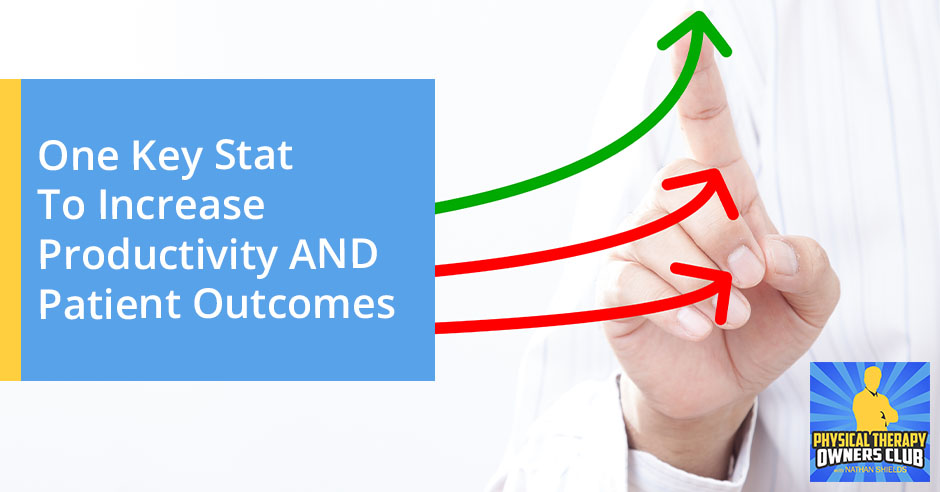
There are many key performance indicators you can use to measure productivity. But there is one key stat you need to increase productivity AND patient outcomes. In this coaching one-on-one episode, Nathan Shields explains what this key stat is and why it’s important. He’ll also teach you how to implement it in your practice ASAP! This is a proven strategy that will transform your practice. What is this key stat? Tune in to find out!
—
Listen to the podcast here:
One Key Stat To Increase Productivity AND Patient Outcomes
I’m going to do another Coaching Moment. My first Coaching Moment was a few episodes ago, where we talked about the importance of the weekly walk-through meetings with your front desk and how imperative it is to improve stats and tracks patients and whatnot. If you didn’t read that one, go ahead and read the first one. I think it’s very important. It’s quick and easy. This one will be a lot the same. After my first Coaching Moment that I did, one of my coaching clients, David Ban, out of Illinois, said, “I liked what you’re doing with the Coaching Moment. I would love to hear you talk about one thing that was super influential for me as your coaching client.” That was the implementation of one particular statistic that he wasn’t tracking in the past and how it significantly improved the efficacy and productivity of his practice.
Since he requested that, I decided I’ll do another Coaching Moment, and I’ll do a few more. I came up with a few other ideas of what we could do for these Coaching Moments where it’s just you and me and not a guest like I usually do. One of the first things that I implement as I do my coaching one-on-one with PT owners is this particular statistic. It’s to improve the efficacy and productivity of their practices. Their patients get better results and are happier. Overall improve financials, which we’re always looking for, an increase to our bottom line. Profits and freedom are what it’s all about here.

This Cardinal KPI has to be tracked. The unfortunate thing is a lot of EMRs don’t track it. You got to do it manually, have your own Excel spreadsheet, and have the front desk do it for you, but you’ve got to track it on a weekly basis. That key statistic is the average visit frequency per week for each patient. It’s the average across your active patient list, but it’s the average number of times they’re coming per week. It’s straightforward. It’s got to be tracked. It’s got to be reviewed in the weekly walk-through that I discussed a few episodes ago and preferably an average that is generated by the clinic and also broken down by provider.
As with most statistics, if you’ve got an average, relatively good statistic that the clinic represents, inevitably there’s 1 or 2 providers possibly that might be bringing it down and 1 or 2 providers who might be bringing it up unless you get average. It’s important with some of these statistics to track both by the clinic and by the provider. That can be said for a number of key statistics, but this statistic tracks patient engagement and their buy-in to the individual provider’s care and the plan of care and how well they essentially sold their services.
You can assume that if most providers were asked, “How many times a week do your patients come into physical therapy in an outpatient orthopedic setting?” Most of them, I’m assuming, would say, “2 to 3 times a week,” and it’s probably necessary 2 to 3 times a week in order to get results. As we track this statistic and have owners manually do it, it ends up not being the case that it’s anywhere near 2 to 3 times a week, which you would think as maybe a 2.5 visit per week average.
You would expect it to be somewhere in that range, 2.3 to 2.5, something like that. Inevitably and routinely, I find that the average would be closer to 1.7, maybe up to 2.0. There are even a couple of clinics that I’ve seen that are closer to 1.0 in certain circumstances, especially if they’ve got a number of new patients wanting to get in and they don’t have enough providers, but that should be a rare case. Nonetheless, what you find is the average between 1.7 and 2.0 when it should be well above 2, closer to 2.5.
What that means to me is there’s a number of patients who are coming one time a week and are not getting better. Frankly, if you read orthopedic studies about the frequency of care in physical therapy clinics and what is needed and necessary in order to make significant gains and improvement, one time a week isn’t enough, especially in those acute cases. When they’re in distress, they need to be coming in more often in order to get results, especially sooner, the better. I usually start with 2.2 visits per week, on average, to be expected in order to get results, improve your metrics and consider your clinic an otherwise efficient clinic or productive clinic. Getting that average, at least up to 2.2 and hopefully, more will help you see significantly greater results without increasing a lot of your expenses.
Make sure you tie your program back to your purpose, values, and your mission. Click To TweetIt’s making some of those financial gains going straight to the bottom line and profits. I don’t just pull that number out of the air. The studies I’ve seen are designated to particular injuries, and one time a week is not sufficient for those particular diagnoses. One article that I did find through the help of a friend was in orthopedic practice 2017, a study by four physical therapists titled Association Among Select Clinical Data and Successful Completion of a Treatment Plan in An Outpatient Orthopedic Physical Therapy Setting.
Four therapists from Rhode Island, Mark Bastan, Ryan Toher, Michael Nula and Jason Harvey, looked at the data that they collected from 669 discharged patients between five months of a particular year to see how well they progressed. Also, if they could correlate their progression, gains and successful discharge essentially to the number of times that they came per week on average for their care. What they found was what you would expect, but unfortunately, we don’t see in a lot of clinics, and that is, “Maintaining a frequency of two visits or more per week led to successfully completing the treatment plan 93% of the time with a normal discharge.”
Compare that to the average visit frequency and the correlated successful discharge rate to those who were saying 1.0 to 1.66, 1.67 average visits per week. The range of successful discharges is between 48% on the low end at one time per week and 69% on the high end. Whereas if they come a minimum of two times per week on average, there’s a 93% chance that they’re going to be successfully discharged. What does that mean to you? It could mean a whole cascade of positive effects if they came in the average frequency they’re supposed to come per week and the total number of visits.
They’ll go on and say, “Keeping in mind that the number of visits per week, as an average, a therapist can decide to adjust the frequency of visits in order to be sure the average is maintained. It is within the scope of physical therapist practice for the therapist to set and adjust the frequency of treatment as part of the plan of care.” For example, if a patient is only able to attend therapy once during a particular week, it may be beneficial for him or her to attend three times the next week in order to maintain an average of twice per week.
The results of this study suggest that controlling the number of average visits a patient attends per week leads to greater outcomes. In this show, we’re always talking about how to increase freedom and profits for the owner, what they can do, how they can improve. We got to understand that what we do that is beneficial for patients is ultimately beneficial for our businesses as well. One of those key stats is this, in particular, the average number of times per week.
They took it a step further that they say, “Our study suggests that in relation to other data, patient attendance is the single most important factor in making sure someone follows through to completing successful outcome.” Side note, I’ve shared with you the percentage on this show before. Hopefully, you understand, and it could vary depending on your source. Professionally industry-wide, the average successful discharge rate, what I’ve learned as was the percentage of completed plans of care on a routine basis for outpatient orthopedic clinics is 15%.
The 15% of our patients who come in the door finish through their full plan of care, which is pathetic, and they’re not getting results. That’s why we might hear through different channels that physical therapy doesn’t work. That’s not good for business because patients aren’t getting better. We’re not selling our services and pushing these key statistics will help us improve. “When a patient is prescribed physical therapy treatment two times a week over the course of six weeks, the expectation is the patient will be seen for all twelve visits over the six-week plan. Data from our study shows that if a patient only attends 10 of the 12 visits during a six-week plan, then an average visit per week, a total of 1.67 visits over the six-week plan, was achieved. This would result in a 64% successful discharge rate.”
“If the same patient attended 11 visits out of the 12 initially prescribed visits over that same six-week plan, the average number of visits per week would have been 1.83 visits per week with a successful completion rate of 93%. The difference supports the importance of maintaining patient attendance, even when it means attending one more visit.” If you look at those numbers and based on their wording, there is a 68% chance for improvement if the patient comes one more visit, at least, between the 10th and 11th visit. That’s the importance that needs to be stressed. It needs to be understood for you as the owner and also for the providers in your clinic, the importance of coming of patients coming for every single visit. Them not showing up means a decreased likelihood of their success with physical therapy.
Coming in 2 to 3 times a week for a full plan of care can provide a significant improvement in patient results. That improvement to this particular statistic alone improves our financials. Imagine if you’re at 1.7 and you go to 2.2 visits per week on an average, that right there’s a 33% increase in revenue, right to the bottom line, without any additional marketing spend. You have mostly fixed expenses. All that money goes down to the profit bottom line. As it’s noted in the study, it increases successful discharges, patient’s results, your reputation in the community, physician referrals, improves the efficiency of care and increases revenues.

Imagine what happens on the flip side when we continue to have a 15% completed plan of care rate or based on the graph that they shared, if our general active patients are coming in 1.5 times per week versus 2.0 well, that’s a 22% decrease in successful discharges. A whole cascade of issues can occur because of the poor discharge rate and completed plans of care. Increasing compliance through full plans of care to successful discharge is hugely valuable, and it starts with training the providers. How do we do that? We got to get the providers on board.
The first thing you got to do is maybe share a report like this with some data to back you up and allow the opportunity to discuss it with your providers, the importance of coming in multiple times per week versus single visits. There’s the outlier. There are patients that come in for their home exercise program, or maybe they’re just finishing up care. There’s one more visit. I’m encouraging some of my clients now to do one follow-up visit two months out after discharge to make sure there’s no regression. I’m scheduling that out at the last visit.
Those are the outliers and there should be exceptions that are deviations from the rule in general. Share the report, discuss with your providers and then find your particular statistic for average visits per week and compare that to what it should be or what it could be, especially based on the chart they provide in the study. Note, as you’re starting to talk about this kind of statistic, you want to make sure you tie it back to your purpose, values and mission. Otherwise, it’s just going to fall flat. They’re going to think, “You’re trying to improve your business, line your pockets, and improve your bottom line.”
You never want it to get to that point. You want to ensure that this particular stat or any stat or any program you implement is tied back to your goals, purpose, and mission. Ultimately, your purpose as an outpatient orthopedic clinic is to provide the best care to the most number of patients in your surrounding community as possible. If you’re not providing the best care, which includes an appropriate number of visits and frequency, then you’re not fulfilling your purpose.
If your values are high-quality physical therapy, this is one of those measurements to measure if you’re providing high-quality therapy. You can do a great job in singular visits, but it needs to be consistent work. We can agree on that. Share the report and your statistic compared to what the expectations are, at least in this study. Tie this statistic and the importance of tracking it back to purpose, mission and values, and then come to an agreement on a goal with your team of what should be expected and then have follow-up dates.
What can that goal be in 6 or 12 months? Schedule times in your staff meetings to track this particular goal along with others that you should be tracking and make sure you’re tracking it on a weekly basis yourself with your front desk. Go back to committing to being a three-time-per-week practice. That is one thing that a few of my clients have done and seen great results from it is they are a three-time-a-week practice. If a patient comes in and wants to be seen for therapy, we’re going to get them scheduled three times a week for the first four weeks, at least at the initial evaluation.
Share profitability to unlock possibility. Click To TweetThus, they’re able to see greater results and completions of plans of care. Patients are happier, and the efficiency and productivity of their clinic improve without increasing the marketing bottom line. This key statistic, average visit frequency per week, can significantly change your business for the better for your patients and yourself. Remember the quote that my friend, Will Humphreys, always shares, “Profitability unlocks possibility.” What could you do with the increased profitability of your clinics?
Following a key statistic like your skilled units per visit on average, these kinds of statistics can significantly improve your financials without increasing expenses and no additional marketing ad. It does go back to the bottom line, which you could then reinvest in the business, in other providers and other programs that can do more like a clinic to achieve your goals and purposes. You can do more and you can achieve your goals. That’s my Coaching Moment for the day. Become a three-time-per-week practice. That’s my Coaching Moment. Have a great day.
Important Links:
- Coaching Moment – Previous episode
- Association Among Select Clinical Data and Successful Completion of a Treatment Plan in An Outpatient Orthopedic Physical Therapy Setting
Love the show? Subscribe, rate, review, and share!
Join the Physical Therapy Owners Club today: